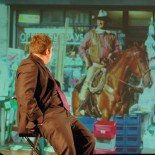is enjoyment a criteria for evaluation?
One issue which came up unexpectedly but informatively at the Performing Impact workshop was that of “enjoyment”. Whilst discussing the ways in which the focus of evaluation might be directed away from the social sciences vocabulary of “impact” and towards a more arts-centred approach, one practitioner remarked that they had never seen “everyone enjoyed themselves” on an assessment report. They suggested that this should be the first line of any evaluation, since it was such a central element of the experience of the arts, and an intrinsic part of what makes engaging with them worthwhile.
This was challenged by another practitioner, who suggested that this would risk emphasizing the wrong aspects of what community arts have to offer. After all, they pointed out, a game of darts could provide a great deal of enjoyment, but no-one in the workshop would propose that we should ask funding bodies to roll out darts programmes across the country. (Despite the number of pub landlords who have told us over the years that the woeful state of mental arithmetic amongst the British population is a direct result of the decline of darts leagues.) Each person present was there because they had a strong belief in the particular value of their artistic practice and “enjoyment” was too thin and trivial as a justification for the time and effort community arts demand, or a description of their effects on participants.
As the discussion widened to take in the potential ways of understanding “enjoyment”, and the part it should have in our account of the arts’ potential impacts, there was a general agreement that the pleasurable element of artistic engagement was significant, but that it needed to be nuanced as an idea. At what point should enjoyment be considered? Many of the projects referred to during the workshop had involved emotional and practical challenges to the participants, but those had been justified by the end outcomes and the way those challenges had been overcome. Given our focus on “process” over “product” in community arts, we were struck by the contrasts between kinds of value which seemed to be expected at differing points during a project.
The conversation was also deepened by reference to an educational theatre project which had found young children’s retention of the scientific and social ideas explored by a performance was strongest when mediated via moments of emotional engagement. They seemed to be most able to recount and use the particular ideas which they linked to dramatic and affecting events in the show. This encouraged us to think about “enjoyment” not as a hook which with to catch participants so that benefits and impact could be deployed, but as an intrinsic part of what takes place as we engage in artistic projects. From this angle, “enjoyment” should not be seen as a shallow but necessary stage through which participants pass on their way to the “real” art, it is the site of learning and of enlarging our understanding. This perspective sits strikingly alongside the thinking we have been doing around affect and embodiment [LINK], exploring ways to break down the rhetorical distinction between an abstract realm of thought and a concrete world of action.
These are just a selection of the points which were put forward during this discussion, and we would love to hear your input on them.
Do you think “enjoyment” or “pleasure” needs to be brought more robustly into our account of community art and its benefits?
What might “enjoyment” mean in the context of your work – spectacle, physical activity, socializing, laughter?
Could it stand for a raft of elements which are too often marginalized by abstract and cerebral descriptions of art?
Or do you feel that this emphasis might trivialise the processes and experiences which we undertake within art practices?
Do you think it would risk an overly “relative” account of the subject, in which anything which feels good could justify itself?

